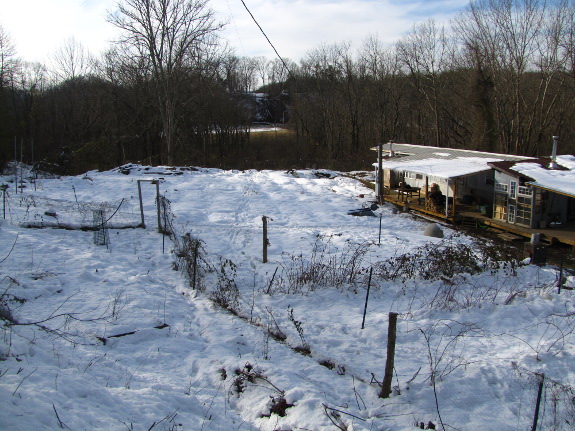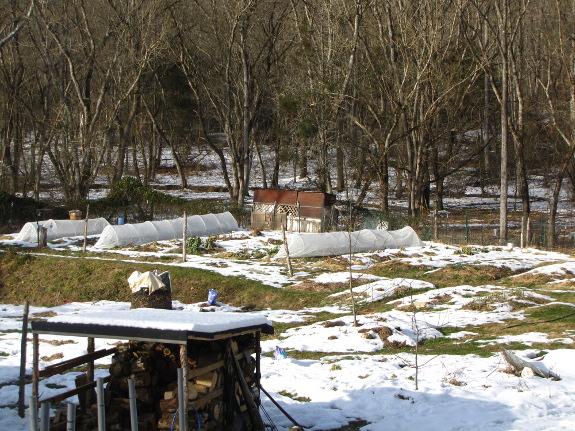
North-facing hillside

I write about our
north-facing hillside a lot, but I only realized a few weeks ago that
the term isn't self-explanatory to all our readers. Basically, a
north-facing hillside...um...faces north. That means if you're
standing on the hill and looking down, you're looking to the north, so
in the northern hemisphere, you'll end up with a lot more shade in this
type of landscape compared to on a south-facing hillside. In the winter,
especially, it's much colder the closer you are to the steep slope of a
north-facing hill since the higher land blocks morning and evening sun
for areas at the hill's feet (due to sun
angles).
To illustrate my point,
I walked up on the powerline
pasture terrace and
took some shots of our homestead from above. The first photo in
this post is what we call the front garden, which is closest to the
hillside. A week after the big
snow, this area is
still deeply covered because there's barely been any direct sun hitting
the ground.

The second photo shows
the mule garden and the southern chicken pastures. This is at the
southern extreme of our core homestead, meaning it's as far away from
the hillside as possible. I took both of these photos at the same
time so you can tell that being further away from the hillside is a
major boon in terms of winter sun. (You can also tell that the quick
hoop on the right
has mostly bounced back with a little TLC.)
North- and south-facing
hillsides both have their advantages and disadvantages (and southern
hemisphere readers should, obviously, flip the terms around for their
homesteads). I nestle summer chicken pastures up against our
hillside, but put the winter chicken pastures down in the sunniest
spot, along with our winter garden. Cool-loving plants like
currants and gooseberries enjoy the cool microclimate of the
north-facing hillside, and I keep meaning to try some peaches up there
to see if the cold will retard bloom enough to miss late frosts.
If I had a south-facing hillside, it would be great for solar panels
and fungus-prone plants.
In general, it's easier
to take sun away (with shade trees) than to add sun, so unless you live
in a very hot region, south-facing hillsides are preferred for most
homesteaders. But if you're picking an ugly duckling property,
north-facing hillsides aren't so bad.
Want more in-depth information? Browse through our books.
Or explore more posts by date or by subject.
About us: Anna Hess and Mark Hamilton spent over a decade living self-sufficiently in the mountains of Virginia before moving north to start over from scratch in the foothills of Ohio. They've experimented with permaculture, no-till gardening, trailersteading, home-based microbusinesses and much more, writing about their adventures in both blogs and books.
Want to be notified when new comments are posted on this page? Click on the RSS button after you add a comment to subscribe to the comment feed, or simply check the box beside "email replies to me" while writing your comment.

I think Bill Mollison had the right idea in using terms such as "sun-side" or "Sunwards" and "Shade-side" or "polewards" to keep his writing useful for people in both hemispheres. Just a thought.
wholeviewfarm.blogspot.com
do you have any plans for the bank up to the mule garden? that area looks like a great place to plant perennial veggies and flowers. maybe you could lightly terrace it and plant things like ramps, Jerusalem artichokes, and self seeding flowers! sorry, i don't have open land to work, so i live vicariously though you folks...
i really think you should consider taking more photos from the powerline pasture terrace. it's a great perspective on the farm. before these shots, i didn't realize how varied the terrain is within the core homestead!
Joe --- I always found those terms even more confusing for folks who aren't easily able to visualize what the sun does in the winter. Simpler for folks in other hemispheres, but probably harder for the mainstream American.
Kathleen --- We did chop down a lot of young trees to make our core homestead accessible --- it was quite an undertaking! They had all grown up in the last 50 years, so weren't very big, but there were a lot of them (and blackberry briars and Japanese honeysuckle). Here and there, we're still reclaiming parts of the core homestead.
Kevin --- That's the side of what I generally call the gully, and it is definitely the sunniest spot in the winter. Until this summer, you couldn't even get there for the brambles, and we're hoping one more year of weedwhacking will kill enough honeysuckle that we can start to use the space. By this time next year, we should know if our quick and dirty terraces work in the powerline --- if so, we'll probably try them there too and maybe grow some winter crops in the space.